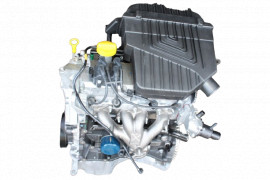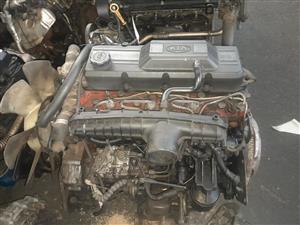Opel Corsa Engine: Common Issues and How to Repair Them
Opel Corsa Engine: Common Issues and How to Repair Them
Blog Article
Exploring the Inner Operation of a Compact Automobile's Engine System
As motorists, we commonly take for granted the intricate processes that occur within the boundaries of our lorry's engine system. The compact yet complex machinery that propels us onward is a marvel of design precision and sychronisation. From the controlled surges in the burning chamber to the careful timing of gas injection, every element plays a crucial role in the smooth procedure of the engine. In this exploration of a small lorry's engine system, we will unwind the internal functions of this mechanical symphony, losing light on the secrets that drive us forward on our daily trips.
Combustion Refine Overview
The burning procedure in a portable vehicle's engine system is a vital system that successfully transforms fuel into power to power the car. This process takes place within the combustion chamber of the engine, where fuel and air mix, fire up, and create controlled surges. The combustion process contains four major phases: consumption, power, compression, and exhaust.
During the intake phase, the piston moves downward, attracting a combination of air and fuel into the burning chamber. The next phase, compression, entails the piston relocating upwards, pressing the air-fuel mixture to boost its effectiveness. Ultimately, in the power stage, the ignition system fires up the compressed combination, leading to a fast expansion of gases that requires the piston pull back. This descending activity creates the power required to drive the car. In the exhaust phase, the burnt gases are expelled from the burning chamber through the exhaust shutoff, preparing the chamber for the following cycle. This cyclic combustion process is essential to the operation of a compact lorry's engine system, guaranteeing efficient power conversion for propulsion.
Piston and Cylinder Interaction

The piston's exact fit within the cyndrical tube is crucial for maintaining optimum compression and stopping energy loss throughout burning. Limited clearances in between the piston and cylinder wall surfaces ensure reliable securing, allowing the piston to relocate smoothly without permitting gases to leak past. Correct lubrication is also vital to reduce rubbing and put on in between these components, improving durability and efficiency.
In addition, the style and materials made use of in producing the piston check over here and cyndrical tube impact engine efficiency and longevity. Modern engines commonly employ light-weight yet resilient materials like aluminum alloys for pistons and cyndrical tube linings to minimize inertia and enhance thermal performance. Generally, the harmonious interaction in between the piston and cylinder is basic to the engine's capability and total performance.
Gas Injection System Capability
Gas shot systems in compact car engines play a vital function in precisely providing gas to the combustion chamber for effective and controlled ignition. The gas shot system functions by infusing fuel right into the combustion chamber at the ideal minute during the engine's operation (opel corsa engine). This accurate timing ensures that the fuel blends equally with the air for proper combustion, bring about improved gas performance and reduced discharges
There are mainly two types of gas shot systems made use of in compact lorry engines: port gas shot (PFI) and straight gas injection (DFI) PFI systems inject gas into the consumption port before the intake valve, while DFI systems infuse fuel straight into the burning chamber. Both systems have their advantages, with DFI providing far better fuel atomization and PFI giving a more affordable remedy.
Understanding Engine Cooling Mechanisms
Efficient operation of a compact car's engine depends greatly on the effectiveness of its cooling devices. The cooling system in a compact automobile typically consists of a number of components working with each other to manage the engine temperature level. Comprehending these engine air conditioning mechanisms is vital for keeping the performance and long life of a compact car's engine system.

Exhaust System Parts Explained
The ideal performance of a portable lorry's engine cooling devices depends on a corresponding system understood as the exhaust system, which makes up various essential parts for making certain effective emissions and engine efficiency. The exhaust manifold collects exhaust gases from the engine's paths and cyndrical tubes them to the catalytic converter.
One crucial part of the exhaust system is the oxygen sensor, which monitors the oxygen degrees in the exhaust gases to help control gas intake and guarantee optimum engine performance. opel corsa engine. Furthermore, the resonator might exist in some exhaust systems to decrease noise degrees. Generally, the exhaust system plays a crucial function in keeping engine effectiveness, reducing damaging emissions, and making sure a quieter driving experience for small automobile owners

Conclusion
In conclusion, the compact automobile's engine system is an intricate combination of elements that work with each other to help with the combustion procedure, convert fuel into power, and remove waste gases. Understanding the pop over here internal workings of the engine system, consisting of the piston and cylinder interaction, fuel injection system, engine cooling mechanisms, and exhaust system components, is critical for keeping ideal performance and performance of the car.
The burning procedure in a portable find out here now vehicle's engine system is an important system that successfully converts gas into power to power the automobile.Fuel injection systems in portable vehicle engines play a crucial duty in precisely supplying gas to the burning chamber for regulated and reliable ignition.There are mostly two types of gas injection systems used in portable automobile engines: port gas injection (PFI) and direct fuel injection (DFI) Understanding these engine air conditioning mechanisms is essential for maintaining the efficiency and long life of a small vehicle's engine system.
The optimal performance of a compact car's engine cooling devices depends on a corresponding system known as the exhaust system, which makes up numerous necessary elements for making sure efficient exhausts and engine efficiency.
Report this page